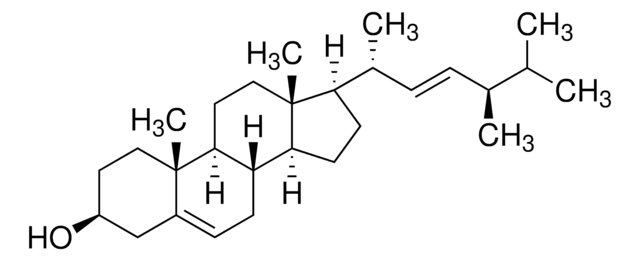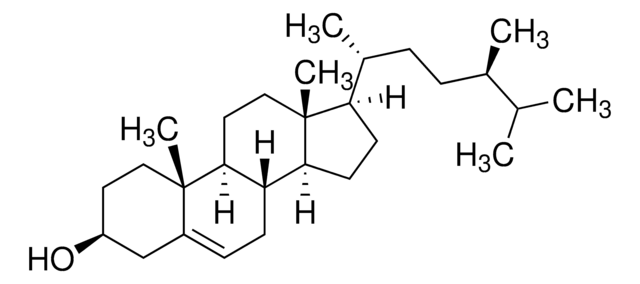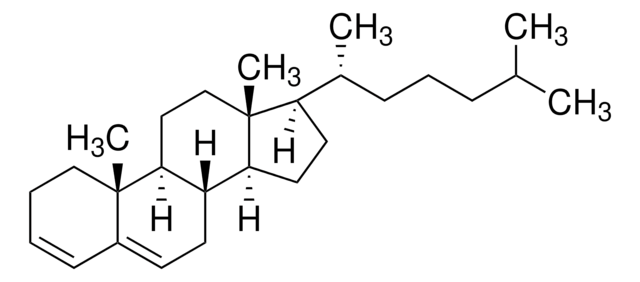C8003
5-α-Cholestane
≥97.0% (HPLC)
Synonym(s):
NSC 224419
Sign Into View Organizational & Contract Pricing
All Photos(3)
About This Item
Empirical Formula (Hill Notation):
C27H48
CAS Number:
Molecular Weight:
372.67
Beilstein:
2051806
EC Number:
MDL number:
UNSPSC Code:
12352211
PubChem Substance ID:
NACRES:
NA.77
Recommended Products
Quality Level
Assay
≥97.0% (HPLC)
form
powder
mp
80-82 °C (lit.)
SMILES string
CC(C)CCC[C@@H](C)[C@H]1CC[C@H]2[C@@H]3CC[C@H]4CCCC[C@]4(C)[C@H]3CC[C@]12C
InChI
1S/C27H48/c1-19(2)9-8-10-20(3)23-14-15-24-22-13-12-21-11-6-7-17-26(21,4)25(22)16-18-27(23,24)5/h19-25H,6-18H2,1-5H3/t20-,21-,22+,23-,24+,25+,26+,27-/m1/s1
InChI key
XIIAYQZJNBULGD-XWLABEFZSA-N
Looking for similar products? Visit Product Comparison Guide
Application
5-α-Cholestane has been used:
- as an internal standard in gas phase chromatography (GC) and high-performance liquid chromatography (HPLC) to quantify cholesterol in meat products for a comparison study
- to quantify the active compounds in the oils using a gas chromatograph coupled to a mass spectrometer
- as a reference standard in GC analyses to quantify sterol content in the unsaponifiables obtained from oat lipids and different sterol standards like fucosterol, sitosterol, campesterol, and stigmasterol
Biochem/physiol Actions
5α-Cholestane is a sterol produced endogenously from cholesterol and has been isolated from human feces. It is derived from cholesterol by the action of intestinal microorganisms. Derivatives of 5α-cholestane in plants are called brassinosteroids that selectively activate the PPI3K/Akt pathway.
Preparation Note
5α-Cholestane yields clear to slightly hazy, colorless to faint yellow solution in chloroform at 50 mg/ml.
Storage Class Code
11 - Combustible Solids
WGK
WGK 3
Flash Point(F)
Not applicable
Flash Point(C)
Not applicable
Personal Protective Equipment
dust mask type N95 (US), Eyeshields, Gloves
Choose from one of the most recent versions:
Already Own This Product?
Find documentation for the products that you have recently purchased in the Document Library.
Customers Also Viewed
Comparative Analysis and Validation Methodologies of GC and HPLC for Analysis of Cholesterol in Meat Products
Stroher GL et al
American Journal of Analytical Chemistry, 3, 306-311 (2012)
L J Chen et al.
Journal of agricultural and food chemistry, 58(19), 10467-10474 (2010-09-11)
The objectives of this study were to develop a GC-MS method for determination of cholesterol oxidation products (COPs) in tea-leaf eggs and study the formation and inhibition of COPs as affected by heating time and various ingredients in marinated juice.
Stefanie M Hixson et al.
PloS one, 11(3), e0152264-e0152264 (2016-03-25)
Nutritional enhancement of crops using genetic engineering can potentially affect herbivorous pests. Recently, oilseed crops have been genetically engineered to produce the long-chain omega-3 polyunsaturated fatty acids, eicosapentaenoic acid (EPA) and docosahexaenoic acid (DHA) at levels similar to that found
Abdulaziz A Alaqil et al.
Animals : an open access journal from MDPI, 10(9) (2020-09-10)
This study examines the effect of dietary supplementation with Lactobacillus acidophilus (LA) on the cholesterol levels, immune response, and productive performance of laying hens. A total of 216, 40-week-old, commercial Hy-Line brown chicken layers were randomly assigned into four treatment
Caroline Schönning et al.
Water research, 36(8), 1965-1972 (2002-07-03)
Transmissible pathogens in source-separated human urine, intended for reuse in agriculture, mainly originate from faeces that cross-contaminate the urine. The health risks associated with the enteric pathogens will largely be dependent on their initial concentration and their inactivation during storage
Our team of scientists has experience in all areas of research including Life Science, Material Science, Chemical Synthesis, Chromatography, Analytical and many others.
Contact Technical Service









